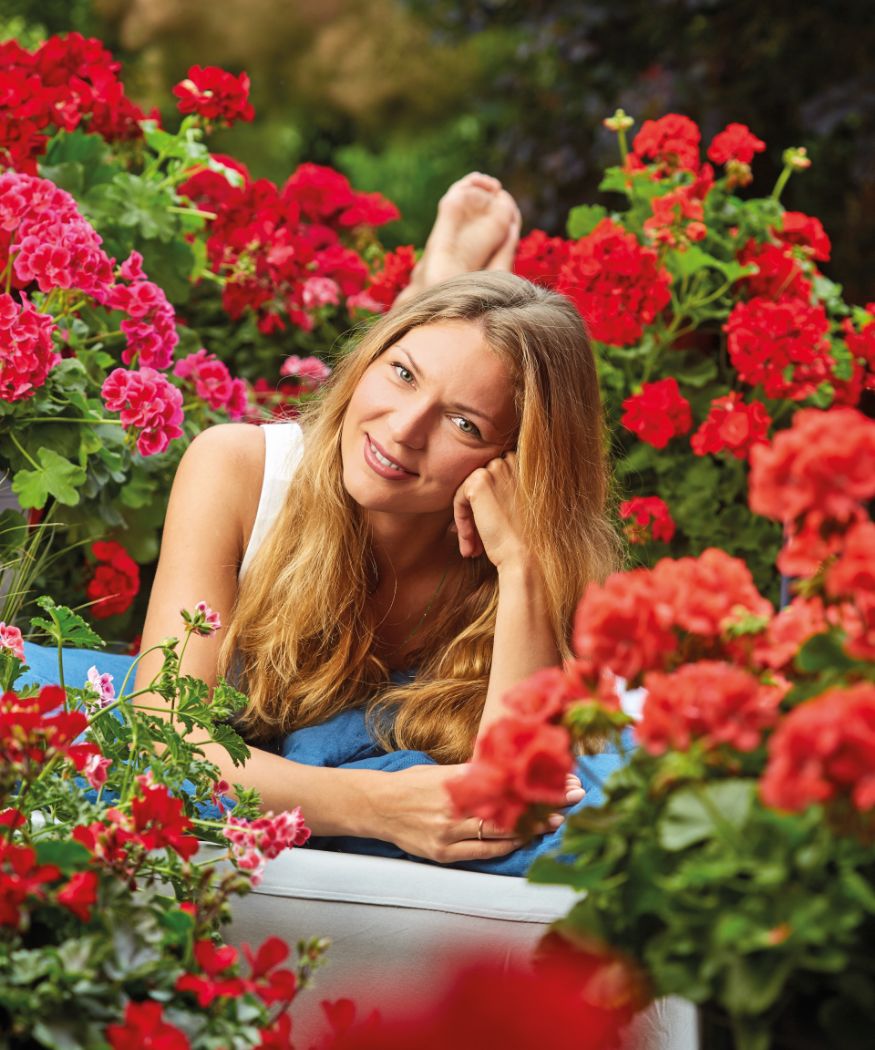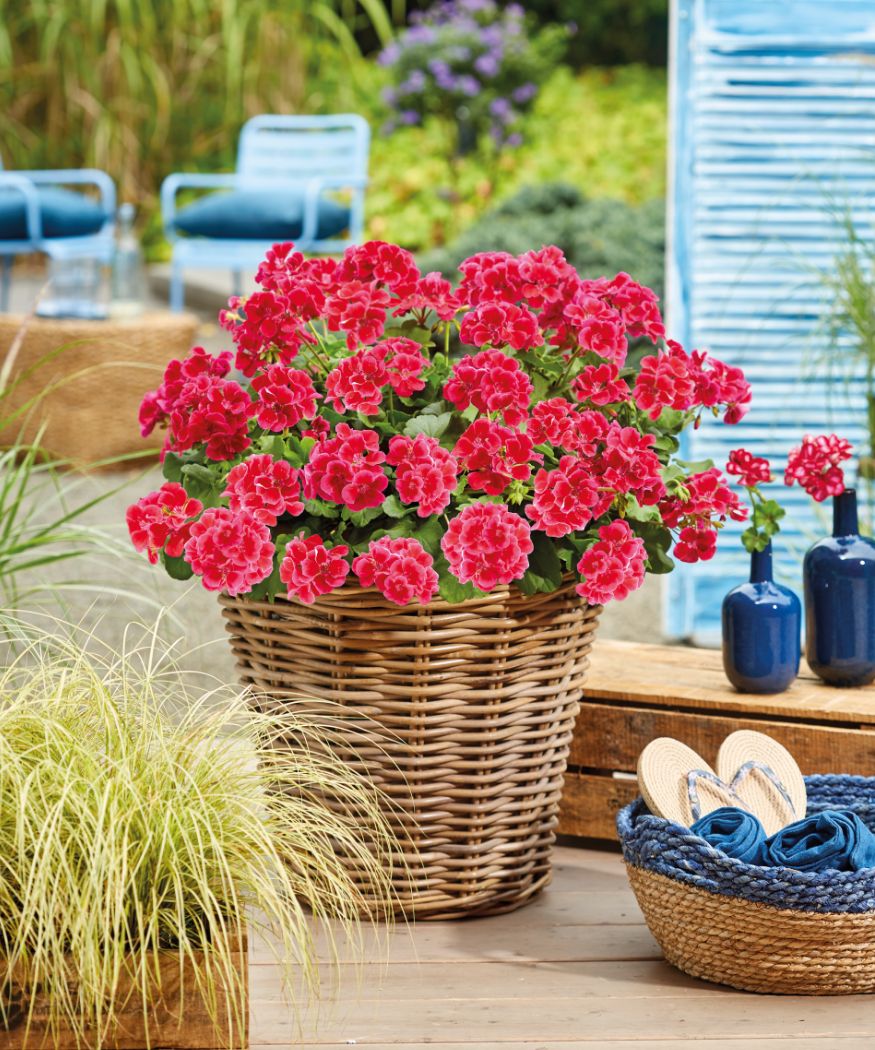No summer garden or colourful balcony would be complete without them:
Profusely blooming geraniums in a wide spectrum of bright colours. Not only in the country are they an integral part of summer feeling, in towns and cities they also add beauty to our surroundings.
Easy-care geraniums don’t need a lot to thrive and flower beautifully:
Just a suitable location, sufficient water and food as well as a proper planter or pot. Even for people without a green thumb or a lot of time to care for plants, this hardy summer stunner is the perfect choice. The experts from Pelargonium for Europe reveal some simple tips for getting this versatile South African to show her best side from spring to autumn, even in our latitudes.
Timing
Once temperatures have risen to a comfortable double-digit range during the day and the nights are frost-free, it’s the perfect time to set geraniums outside. As a rule, this is after Cold Sophia, the last of the Ice Saints, has brought the last frost in mid-May.
Location
As geraniums originate from the Cape region of South Africa, they feel most at home in a warm spot with full sun or at least partial shade. Even direct midday sun in the summer months is no problem for these plants. The more hours of sun they get, the more flowers they will produce. Semi-double and double geranium varieties and cultivars with big flowerheads only like a bit of moisture from above, which makes them perfectly suited, for example, for balcony boxes that are protected by a rain canopy. Single-bloom varieties, on the other hand, have no problem with the rain.

Containers
Geraniums grow especially well when they have lots of space. If they are planted too close to other plants or if the plant container is too small, they will not reach their full flowering potential. Optimally, a balcony box or container should have a minimum depth of 18 centimetres and the plants should be spaced at least 20 centimetres apart.
Watering
As temperatures rise and geraniums grow and produce flowers, their water requirements also increase. They don’t mind even prolonged heat waves as long as they are watered regularly and sufficiently. The plants should never be allowed to dry out completely, but waterlogging must be avoided too. Excess water must always be able to drain off to prevent root rot. It’s best to water the plants slowly and in small amounts and on really hot days they can even be watered in the morning and evening. Special self-watering systems from garden centres or nurseries or DIY solutions with plastic water bottles can make the job easier. A rough guide for the right amount of water is: ten percent of the volume of the pot per watering, which corresponds to about half a litre per plant in a 20-centimetre pot.
Fertilizing
Geraniums have comparably high nutrition needs. Using a geranium potting mix with slow-release fertilizer will guarantee an optimal diet for the plants right from the start. The manufacturer’s instructions on the package will tell you how long the nutrients should last. When choosing slow-release fertilizers it’s advisable to look for products with a 9-month longevity. This refers to an average temperature of around 20° C. As the soil temperature in balcony boxes is often higher in summer, the fertilizer will be depleted sooner. Alternatively, a standard fertilizer for geraniums or other flowering plants can be added to the watering can about once a week. It is a sign of nutrient deficiency when the leaves turn yellowish and flowering subsides. From September onwards, feeding can be reduced and even stopped completely during overwintering in the plants’ winter quarters.
Care
Removing spent flowers and yellowed leaves on a regular basis is not only for keeping the plants looking good. This way, the geraniums are stimulated to produce new flowers rather than forming seeds. Deadheading is therefore especially important with semi-double and double varieties. This is accomplished by holding the spent flower stem near its base between the thumb, fore- and middle finger and snapping it off. Self-cleaning geraniums, primarily found among the trailing varieties, drop their spent blooms all on their own and generally produce new buds immediately.
Overwintering
If you want to keep your beloved perennial geraniums and enjoy their pretty flowers again next year, you can overwinter them indoors. All you need is enough space, a bit patience and dexterity. The plants must be pruned before the first night frost to a height of about 15 cm and brought inside to a bright, frost-free place. Additionally, the leaves can be removed to reduce moisture loss through evaporation. This has two further advantages: there is less contact surface for pests and the plants will take up less space. Temperatures between 5 and 10° C are ideal for the dormant period. During the winter months the plants need little water, which can make them appear to be dead. But if all goes well, they will bounce back to life in spring as temperatures rise and the plants are given more water.
After overwintering, geraniums should be replanted in fresh substrate. The plants should be gradually re-introduced to outdoor conditions. From February, geraniums that have overwintered in a dark place can be moved to a light, cool location and from April, they can also stand outside on frost-free days. The important thing is to always protect the plants from night frost and too direct sunlight.
 English
English Dansk
Dansk Deutsch
Deutsch English
English Español
Español Français
Français Hrvatski
Hrvatski Italiano
Italiano Magyar
Magyar Nederlands
Nederlands Norsk
Norsk Polski
Polski Română
Română Slovenský
Slovenský Slovenščina
Slovenščina Suomalainen
Suomalainen Svenska
Svenska Česky
Česky Ελληνική
Ελληνική Български
Български